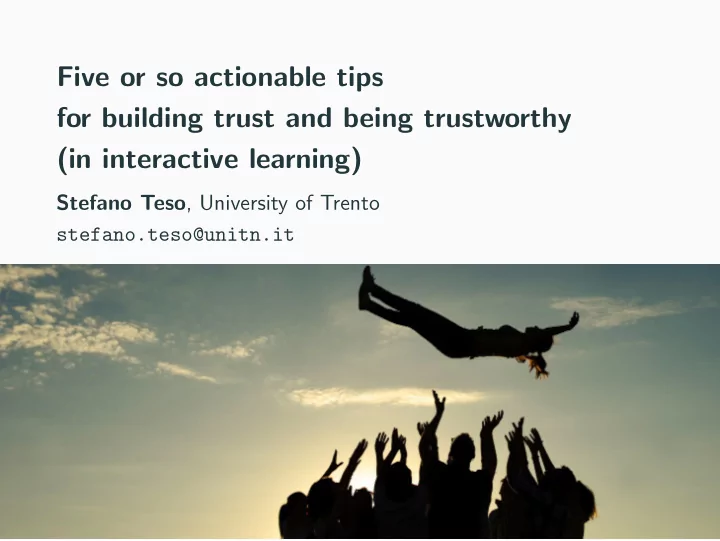

Five or so actionable tips for building trust and being trustworthy (in interactive learning) Stefano Teso , University of Trento stefano.teso@unitn.it
ML increasingly being used in sensitive domains like criminal justice , hiring , . . . Black-box ML models can be whimsical and hard to control How can we build justifiable trust into black-box ML models? 2
How do humans establish/reject trust into others? 1 R Hoffman et al. “Trust in automation”. In: IEEE Intelligent Systems (2013). 2 Luke Chang et al. “Seeing is believing: Trustworthiness as a dynamic belief”. In: Cognitive psychology (2010). 3
How do humans establish/reject trust into others? Understanding Trust involves understanding the other’s beliefs & intentions; it depends on the perceived understand- ability and competence 1 Interaction Trust is updated dynamically, interaction establishes expectations 2 ; it relies on directability (We have “hardware support” for all of this: theory of mind , mirror neurons , . . . ) 1 R Hoffman et al. “Trust in automation”. In: IEEE Intelligent Systems (2013). 2 Luke Chang et al. “Seeing is believing: Trustworthiness as a dynamic belief”. In: Cognitive psychology (2010). 3
How do humans establish/reject trust into others? Understanding Trust involves understanding the other’s beliefs & intentions; it depends on the perceived understand- ability and competence 1 Interaction Trust is updated dynamically, interaction establishes expectations 2 ; it relies on directability (We have “hardware support” for all of this: theory of mind , mirror neurons , . . . ) Alas, explainable AI is passive and interactive ML is opaque 1 R Hoffman et al. “Trust in automation”. In: IEEE Intelligent Systems (2013). 2 Luke Chang et al. “Seeing is believing: Trustworthiness as a dynamic belief”. In: Cognitive psychology (2010). 3
Local Explanations with LIME This helps to identify potential “Clever Hans” behavior 3 , but it does not provide the means to fix it 3 Sebastian Lapuschkin et al. “Unmasking clever hans predictors and assessing what machines really learn”. In: (2019). 4
Active Learning The user a ) does not know the model’s beliefs , b ) cannot affect them directly, c ) has no clue of what his feedback does ! 5
Explanatory Active Learning
Explanatory Active Learning 4 a ) Explain predictions ( competence , understandability ), b ) Allow to correct explanations ( directability ) 4 Stefano Teso and Kristian Kersting. “Explanatory interactive machine learning”. In: 2019. 6
Explanation Corrections 1. User’s correction indicates the false positive segments 2. converts correction to counterexamples , i.e., fill in random values while keeping the same label Example : husky predicted right for the wrong reasons 7
Explanatory Guided Learning and Beyond
On-going work with Teodora Popordanoska and Mohit Kumar (KU Leuven) 8
By witnessing that the model’s beliefs improve over time, the human “teacher” builds trust into the “student” model 9
By witnessing that the model’s beliefs improve over time, the human “teacher” builds trust into the “student” model Problem : nothing prevents the machine from repeatedly choosing instances where it does well. Not so far-fetched: the machine does not know how to choose difficult instances, think of high-loss unknown unknowns 9
Example : dog vs wolf, machine very certain everywhere 10
Example : dog vs wolf, machine very certain everywhere What about unknown unknowns ? 11
Example : dog vs wolf, machine very certain everywhere AL doesn’t help with UUs, uncertainty may be wrong too 12
Idea : let the user choose the challenging instances This is what professors do when testing students 13
Piggy-back on Guided Learning machine chooses rare label, user searches for example Useful for tackling class unbalance where AL fails 14
The human teacher is blind : • impossible to establish justifiable trust • she may provide examples that teach nothing new to the machine How can we expect the human to provide useful examples? 5 5 Interactive machine teaching with black-box models shows that blind teachers cannot do better than random teachers. 15
Explanatory Guided Learning 16
Explanatory Guided Learning 17
Explanatory Guided Learning 18
Explanatory Guided Learning 19
RESULTS 20
Plan : 1. Polish experiments with “imperfect user” 2. Case study with real users (!) 3. Hook up iterative machine teaching theory 21
A “Theory of Mind” for Machine-Human Teams mutual understanding guides trust, learning, and teaching 22
23
24
Recommend
More recommend